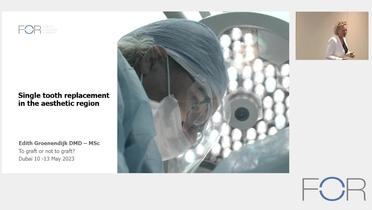Grafting or Graftless - a treatment option for multiple missing teeth
Video highlights
- Treatment option for multiple anterior missing teeth
- Use of bone protein BMP2
- Elevation of bone fragment for defect treatment
In the second part of the 3-part series “To graft or not to graft”, the FOR Experts Dr. Edith Groenendijk, Dr. Ana Ferro and Dr. Jay Malmquist discuss the treatment options including or excluding grafting procedures.
The next presenter is Dr. Jay Malmquist, FOR Chairman of the Board of Trustees and an oral and maxilla-facial surgeon in Portland, Oregon. He introduces his case, a 26-year old male patient, who had multiple attempts to have implants to replace his congenitally missing anterior teeth (#24 & #25 US ,#31 & #41 FDI) in the mandible. The patient has been informed by other clinicians that he couldn’t have implants in the area and should have the teeth restored with a 6-unit bridge. Dr. Malmquist describes the defect, which is 17.5 mm across the top, 7-8 mm vertically, and 7- 8 mm across the bottom and asks the audience to consider how they would address this defect. Would they graft or not? What would be their goal when restoring a defect like this? What could one expect from a restoration attempt? What could be expected regarding long-term stability in such a case? Examining the defect, which technique would one chose for reconstruction? Dr. Malmquist continues to discuss the available treatment options and their applicability to the present case. He refers to two decision trees presented in literature that can assist in determining the appropriate treatment. Additionally, there are several grafting products on the market, the choice of which is often determined by the size of the defect. Dr. Malmquist emphasizes that as a defect gets larger, the need for vascularity also significantly increases. Vascularization of the area is crucial for a good outcome. He introduces a technique that is used frequently in his office called the osteo-periosteal flap. When referring to available literature, highlights that autogenous grafting is widely regarded as the gold standard. He remarks, “…autogenous grafting certainly is an option” and poses the question to the audience, How good are any of us a stacking bone that's autogenous bone or stacking bone that is somehow an allograft or even a xenograft?”
Dr. Malmquist describes the ridge as mature with a large bony defect and the treatment goal to establish contour, the aesthetics, and a long-term solution. He considers the recommendation the patient received from another clinician, to get a 6-unit bridge. Dr. Malmquist highlights the difference in life expectancy of a tooth-fixed bridge versus an implant-fixed restoration. According to insurance industry data in the United States, a bridge typically lasts about 10.3 years and may need to be replaced after 5 to 7 years. Dr. Malmquist’s goals and treatment plan are to develop and maintain a ridge that can carry implants, while considering the aesthetics. Aesthetics are important, even in the mandible, and in particular for this patient who was dissatisfied with a previous treatment. There are various options for regeneration, such as guided regeneration techniques, growth factors and bone proteins, and the concept of mitogen versus morphogen in terms of cell duplication. Block grafts or particulate grafts can also be used. However, Dr. Malmquist chose to do an osteo-periosteal flap and graft in this case.
The surgery began with an incision in the muco- buccal fold. Then, an osteotomy was performed, and the fragment was elevated upwards. Dr. Malmquist emphasizes the importance of vascularity to that pedicled flap. If the pedicled flap is lost, the fragment is lost as well. After making an incision in the bone, the fragment was lofted up. The bone plates were placed close to each other as it was not planned to remove them later. They were also positioned in a way that implants could be inserted with them still in place. The defect was grafted using a recombinant BMP2 bone protein, which is commonly used in the United States. BMP2 is known to be very effective and is mixed with an allograft. Autogenous bone from a different source could have been used to fill the defect, but that would have required opening a second surgical site. The incisions in the bone were made by a special sagittal saw that is safe to use with soft tissue. The screws that hold the fragment in placed were carefully positioned so that there is enough room to place implants. Next, the BMP2 with a mixture of allograft was placed over and in the site. The mixture is not pushed too far and only placed very passively. The protein is placed using a sponge carrier, which will release the protein over the course of 15 days. Before the site is closed, a membrane was placed on the right side for healing purposes. Dr. Malmquist affirms that collagen is chemotactic for fibroblasts and very effective in helping prevent wound dehiscence. The surgery was completed by closing of the surgical site. Dr. Malmquist shared images taken 10 days and 3 weeks post-surgery. He also shares CT scans taken before the treatment and after the treatment to illustrate the integration of the bone plates. It was possible to move the graft up to the cervical region of the adjacent teeth. Two implants were placed with healing abutments. Temporary crowns were placed to give the patient and the treating clinicians an idea of the final result. The patient was even very happy with the temporary crown. Dr. Malmquist closes his lecture with showing images of the final crown and shares his hope that the case illustrated another option in the toolbox of treatments for the audience.
References
[1] Sakkas A, Wilde F, Heufelder M, Winter K, Schramm A. Autogenous bone grafts in oral implantology-is it still a "gold standard"? A consecutive review of 279 patients with 456 clinical procedures. Int J Implant Dent. 2017 Dec;3(1):23. doi: 10.1186/s40729-017-0084-4. Epub 2017 Jun 1. PMID: 28573552; PMCID: PMC5453915.
[2] Ersanli S, Arısan V, Bedeloğlu E. Evaluation of the autogenous bone block transfer for dental implant placement: Symphysal or ramus harvesting? BMC Oral Health. 2016 Jan 26;16:4. doi: 10.1186/s12903-016-0161-8. PMID: 26813232; PMCID: PMC4728796.
[3] Voss JO, Dieke T, Doll C, Sachse C, Nelson K, Raguse JD, Nahles S. Retrospective long-term analysis of bone level changes after horizontal alveolar crest reconstruction with autologous bone grafts harvested from the posterior region of the mandible. J Periodontal Implant Sci. 2016 Apr;46(2):72-83. doi: 10.5051/jpis.2016.46.2.72. Epub 2016 Apr 26. PMID: 27127688; PMCID: PMC4848382.
[4] Chappuis V, Cavusoglu Y, Buser D, von Arx T. Lateral Ridge Augmentation Using Autogenous Block Grafts and Guided Bone Regeneration: A 10-Year Prospective Case Series Study. Clin Implant Dent Relat Res. 2017 Feb;19(1):85-96. doi: 10.1111/cid.12438. Epub 2016 Jul 31. PMID: 27476677.



